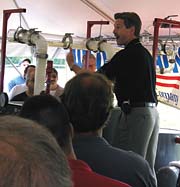
Holohan joked that back in the "old days," it seemed as if someone's boiler blew up every 36 hours. "It was like a national sport," he said. "Steam was wildly out of control."
Holohan told the packed audience that he learned about steam because he was curious. He bought old books and studied the subject. "Anybody can learn about it," he said.
But the session definitely had a serious side. Since many people in his audience were plumbers and wet heat installers and technicians, he made it clear to them that steam heat and hot water had nothing to do with each other.
"Everything you know about hot water heat doesn't apply to steam," Holohan cautioned. "Anything that makes sense in steam will be wrong - like when you crank up pressure, steam will move slower. I used to go on jobs and use my counterclockwise screwdriver and crank down the pressure - and it worked! I made a good living cranking it down."
Holohan noted he targeted specific markets as a "steam heat consultant." "I went after customers with three qualifications: rich, cold, and miserable," he said.
"And telling stories as you are estimating jobs makes you interesting. People want to do business with interesting people."

Evaluating Problems
Holohan takes a very simple approach to diagnosing a steam problem. "I look at the system and not necessarily the symptoms," he said. "Most people will look at a radiator, but I'll go downstairs and look for the origin of the problem."In simple terms, Holohan likes to think in terms of air and where it needs to go. He said there are four things that can be at the root of the problem: air, dirt, piping, and controls.
"With steam, it is all about venting," he stated. "Proper venting will allow steam to move faster. If you can hear a vent making noise, it is not good. That means there aren't enough main vents in the system. Steam doesn't know up from down; it only wants to get out. Think of how steam reacts. Steam should stay in a gas state or it will never get upstairs."
Holohan recommends putting insulation on every steam system, stating that insulated return lines last a lot longer. He also strongly recommends cleaning the system after installation to get rid of the residual chemicals used when boilers are drilled and tapped during the production process.
"We don't take the time to clean the system," he said. "We put the new boiler in and walk away and say that we will deal with the cleaning later.
"Cleaning oils rise to the top of the hot water and steam bubbles trap the oily film. You have to spend an entire day cleaning the system."
Holohan also suggested that techs carry pH paper when working with steam. "You need to raise or lower pH levels to achieve a proper level - one which will not cause damage to the pipes or the boiler."
He said there is a good way to demonstrate how dirty the water is in a system and to prove its detrimental effects on the system to the customer.
"Take a sample of the dirty water and a sample of tap water," Holohan advised. "Put them in similar containers and boil them side by side. The tap water boils nicely, while the dirty boiler water takes longer to boil and then boils violently. Ask the homeowner when was the last time they had their system cleaned. Now they won't blame you for poor system performance."
After Holohan's seminar, he invited attendees to witness a steam heat demonstration sponsored by Weil-McLain (Michigan City, Ind.). Mike Kaiser, Weil-McLain's training and technical manager, demonstrated the steam path of a semi-commercial boiler, rigged with clear plastic piping in the parking lot of the Connecticut Expo Center.
Publication date: 06/21/2004



